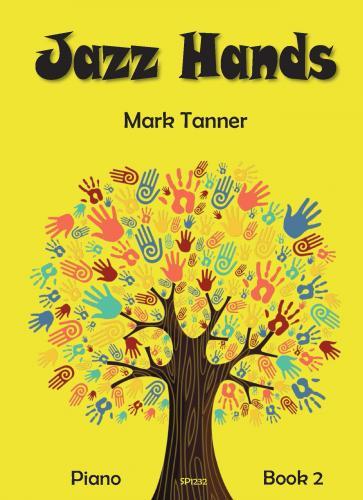Jazz Hands - Book 2
Beschrijving
The Jazz Hands series
Jazz Hands is a series of original jazz pieces for piano by Mark Tanner, which covers all standards from grade one through to red hot.
The title of this series, 'Jazz Hands', derives from the familiar exuberant gesturing seen in music theatre - fingers spread and extended, with palms facing upwards, an effect frequently amplified by a convulsive shivering of the hands. Cheerleaders have tended to make widespread use of jazz hands, while the concept has also found its way into revues, Broadway shows and films, as well as contemporary dance. In the current context I am of course referring to the jazz pianist's hands, which in only the most ambitiously spaced Art Tatum chord would require the player to stretch the digits to such an extent as in the aforementioned theatrical sense.
The term 'jazz' has been adopted and adapted in a multiplicity of ways (not unlike 'classical', indeed), so that it no longer tells us very much about the music itself. Aficionados immediately recognise the better-known subgenres, such as 'bebop' or 'New Orleans' styles, and may even be able to distinguish 'smooth' from 'groove', or 'fusion/ crossover' from 'Postmodern'. And yet these are just labels, not music. In an understandable bid to define all that we hear using such terminology, we may inadvertently place a straightjacket around the music itself, and hence close the door to the possibility of encountering new, innovative jazz styles. Furthermore, the inescapably hefty contribution made by jazz forms to the music of Stravinsky, Debussy, Ravel and Kapustin, to spotlight just a few, clouds the picture irretrievably. Thankfully, nonetheless there are 'givens' aplenty in jazz - 'syncopations', 'back-beats', 'stabs', 'licks' and 'riffs'. In conjunction with these, we cannot fail to notice the presence of 'colour-notes' within the harmonies, alongside the ubiquitous use of jazz modes, typically the blues and diminished scales. The trouble is, that the task of setting down jazz in manuscript turns out to be somewhat troublesome - every bit as hard as when notating 'straight' styles. After all, good jazz playing, just like good Mozart playing, comes down to 'feel', not mere note regurgitation. While the character and impact of jazz music frequently depends upon a tempo which really 'sits' comfortably, it is its rhythmic lifeblood which resists the conventions of notation most stubbornly.
This explains, for example, why jazz composers often find themselves torn between writing dotted rhythms in 4/4 or crotchet/quaver patterns in 12/8. In truth, neither of these is the ideal solution, which is why the simple 'swing' marking, applied to pairs of plain quavers, is probably as good as any method. In practice, such couplets often appear 'semi-dotted', to achieve a wantonly lazy effect, assisted by a subtle emphasis on the second, rather than the first of each pair. Another conundrum for jazz composers is to do with the 'spelling' of the fruitier chords (i.e whether to mix 'n match sharps and flats, or endeavour to be more systematically 'correct'), not to mention the difficulties in pointing out which note in any given chord is the most important, given its fleeting context within a piece. Ultimately, compromises need to be made, so a certain amount of reading between the lines becomes inevitable. Take grace notes, for example, a fairly indispensable expressive device for any jazz player. It may be that, initially at least, these seem to get in the way of crisp, rhythmic playing, but I would encourage the player to thread these in at the outset and allocate the most appropriate fingerings, rather than attempt to bolt them on at some later stage. This way, they will more likely appear natural and spontaneous. In both this and other matters the performer needs to be patient in fathoming what the composer was after, and should aim at all costs to avoid a prosaic, literal presentation. Ultimately, the music will only come to life when both composer and performer see eye to eye.
Most jazz pianists know their 'standards' - 'My Funny
Valentine' etc. These familiar melodies and chord structures
provide the basic canvas upon which embryonic improvisation can
begin. But these are hard-won skills, not garnered overnight, so at
first it may well be advisable to learn set pieces which are
'jazzy', as opposed to 'pure jazz'. Many of the pieces in the first
few books of this series aim to do just that, but before long you
should find it hard to resist adding your own ideas to keep things
fresh and interesting. That said, there are no direct expectations
to improvise in these books - everything has been written out for
you. There are limits to notation, however - take a look at some
of the more elaborate transcriptions of Oscar Peterson's
improvisations and you'll quickly wish you'd never bothered!
Indeed, some of the pieces in these books may at first appear a
little harder to pull off than their classical equivalents for the
grades in question, and yet I have always maintained that it is the
quality of the playing which governs how compelling the music
emerges, not the level of complexity apparent from the page. For
this reason, even a classically- trained grade 8 pianist may have
to work hard to render a grade 3 jazz piece with the confidence and
élan it invites.
Mark Tanner
Contents
- Twill by Twilight
- Cat Flap
- Lament for Typhoon Haiyan
- Loch Jedmon
- The Swashbuckler
- Slow Burn
- Déjà Vu
- Zen and the Art of Cabbage Cultivation
- Three Men in a Boat
- Contemplation
- Unexpected Turbulence
- Winkel Antwerpen : 1 à 2 werkdagen
